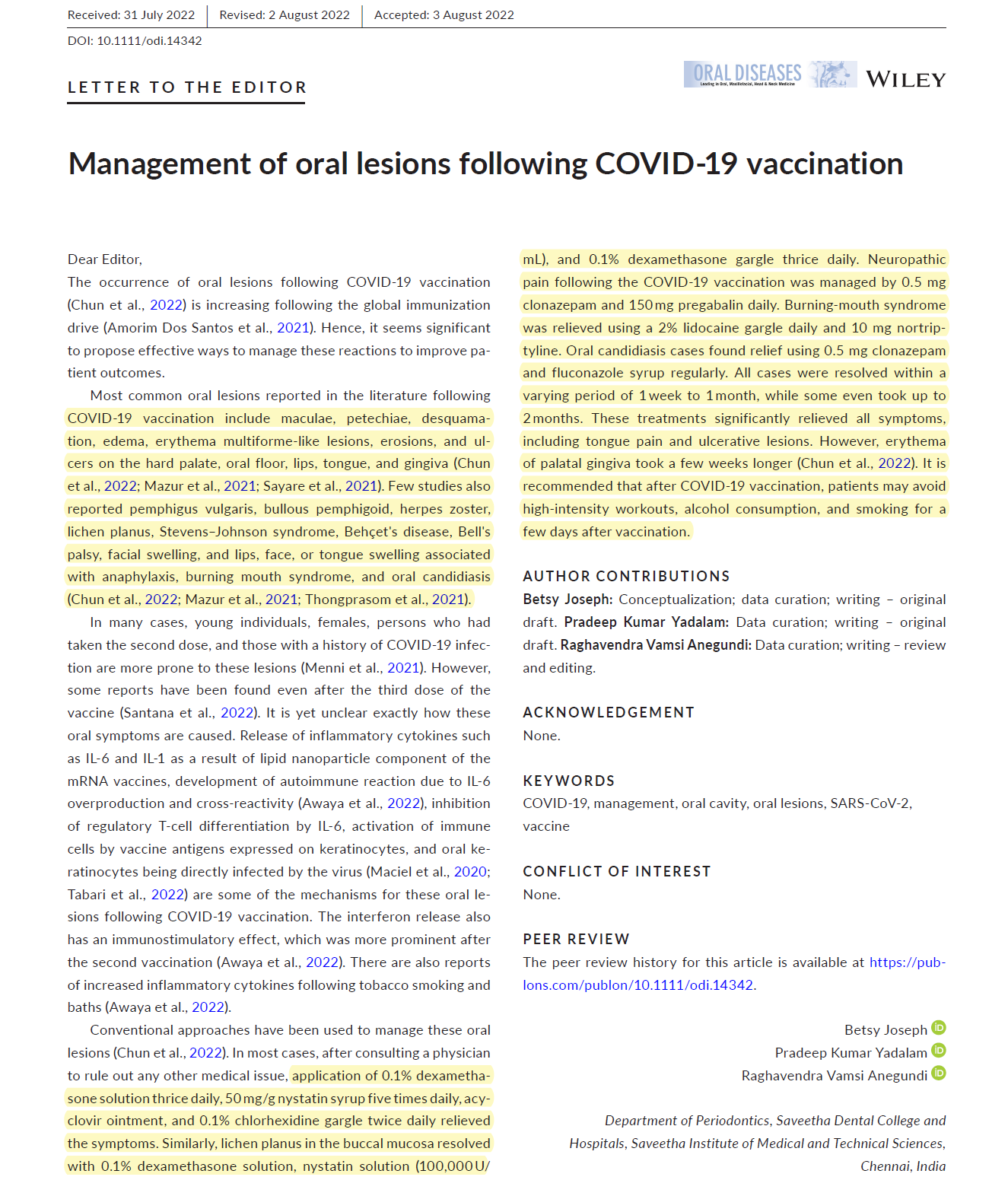Management of Oral Lesions after COVID-19 Vaccination
Practical Solutions to Bothersome Problems after Injection
By Peter A. McCullough, MD, MPH
I recently had a patient who had salivary gland problems after vaccination and when I looked in her mouth I saw unusual lesions at the orifice of the parotid duct. I wondered if there were any solutions.
Joseph et al published a brief summary of the litany of oral/facial problems that develop after COVID-19 vaccination.
“Most common oral lesions reported in the literature following COVID-19 vaccination include maculae, petechiae, desquamation, edema, erythema multiforme-like lesions, erosions, and ulcers on the hard palate, oral floor, lips, tongue, and gingiva (Chun et al., 2022; Mazur et al., 2021; Sayare et al., 2021). Few studies also reported pemphigus vulgaris, bullous pemphigoid, herpes zoster, lichen planus, Stevens–Johnson syndrome, Behçet's disease, Bell's palsy, facial swelling, and lips, face, or tongue swelling associated with anaphylaxis, burning mouth syndrome, and oral candidiasis (Chun et al., 2022; Mazur et al., 2021; Thongprasom et al., 2021).”
Then the authors go on to give some very practical solutions I plan to keep in mind for my clinic.

“In most cases, after consulting a physician to rule out any other medical issue, application of 0.1% dexamethasone solution thrice daily, 50 mg/g nystatin syrup five times daily, acyclovir ointment, and 0.1% chlorhexidine gargle twice daily relieved the symptoms. Similarly, lichen planus in the buccal mucosa resolved with 0.1% dexamethasone solution, nystatin solution (100,000 U/mL), and 0.1% dexamethasone gargle thrice daily. Neuropathic pain following the COVID-19 vaccination was managed by 0.5 mg clonazepam and 150 mg pregabalin daily. Burning-mouth syndrome was relieved using a 2% lidocaine gargle daily and 10 mg nortriptyline. Oral candidiasis cases found relief using 0.5 mg clonazepam and fluconazole syrup regularly. All cases were resolved within a varying period of 1 week to 1 month, while some even took up to 2 months. These treatments significantly relieved all symptoms, including tongue pain and ulcerative lesions. However, erythema of palatal gingiva took a few weeks longer (Chun et al., 2022). It is recommended that after COVID-19 vaccination, patients may avoid high-intensity workouts, alcohol consumption, and smoking for a few days after vaccination.”
Please subscribe to Courageous Discourse as a paying or founder member so we can continue to bring you the truth.
Peter A. McCullough, MD, MPH
President, McCullough Foundation





Dr. McCullough, I listened to your America Outloud podcast Q&A with Malcom yesterday when the subject of xylitol reducing tooth decay came up. You also had a recent Substack piece on this. In your answer to the questioner, you recommended Spry gum. I looked up the ingredients of Spry gum and noted that it contains erythritol, a sweetener that was in the news for possibly causing risk of heart attack, stroke and death. Erythritol is found in some fruits and our red blood cells (erythrocytes) even make very small amounts of erythritol. There was a Cleveland Clinic article on this March 7, 2023. A Mayo Clinic article referred to a 2001 study that showed a 3yr increased risk of major cardiac adverse events. Erythritol was also found to increase the stickiness of platelets. The Mayo Clinic recommends that people avoid erythritol until we know more about it. Do you think it would be wise to avoid products that use erythritol as a sweetener, such as Spry gum? I know you have recommended Spry mouthwash as part of your oral hygiene to protect against COVID. I checked the ingredients of their cool mint flavored mouthwash and erythritol was not listed.
Dr. McCullough, you are the best!!!!! I am a subscriber/patient of The Wellness Company. I cannot tell you how much less anxiety I have knowing that I have doctors I can trust to do tele health appointments if I have any health issues.